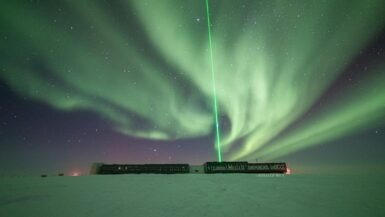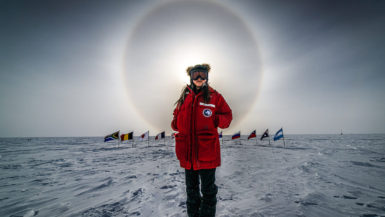
If you’re looking for the best boots for Antarctica but don’t know where to start, I’ve got you covered.
Having worked in Antarctica since 2019, including a year at the South Pole, I know the importance of having top-notch boots for the Ice.
I also worked on cruise ships for three years which has given me unique insight for those sailing to Antarctica.
Needless to say, whether you’re visiting the 7th Continent on a cruise or working in McMurdo, good boots are crucial.
In this post, I’ll cover which boots are best suited for your Ice experience (cruising, hiking, or working) so you don’t have to do any guessing about what to wear in Antarctica.
Editor’s Choice:
⭐ Best Waterproof Boots for Antarctica Cruise Landings: Muck Boot Arctic Ice Tall
⭐ Best Hiking Boots for Antarctica: Columbia Newton Ridge Plus
⭐ Best 200 G Insulated Composite Toe Boots for Working in Antarctica: Timberland Boondock 8”
⭐ Best 1000 G Insulated Safety Toe Boots for Working in Antarctica: Timberland PRO Men’s 8″ Boondock
⭐ Best Non-Slip Boots for Stewards Working in Antarctica: Dr. Martens 1460 Original
[joli-toc]
Disclosure: While I strive to provide thorough and current information, I cannot guarantee its accuracy or timeliness. Please always double-check with your tour company or Antarctic program for the most updated packing information.
Best Waterproof Boots for Antarctic Cruise Landings
First things first: if you’re going on an Antarctic cruise, you probably don’t need to bring your own waterproof knee-high boots for landings.
Double-check that your cruise line either provides or rents them, as this will be the most sensible option.
You don’t want to purchase your own pair of wellies exclusively for this trip for a couple of reasons:
▶️ You might not have a use for them outside of the trip.
▶️ The boots usually end up pretty gnarly after walking around penguin guano (poop) during landings.
Even though the boots are hosed off when going back on board, not everything will get scrubbed out.
Smells linger, and sometimes the treads in the boots can be deep, making it even more difficult to clean thoroughly.
▶️ They take up a lot of luggage space and weight.
The only reason some cruisers purchase their own pair of gum boots is when the cruise line doesn’t have boots in their shoe size.
💡 Pro Tip #1: Check with your cruise line to see what boot sizes they have on board, and make sure to do this well before your trip so you can purchase some if needed.
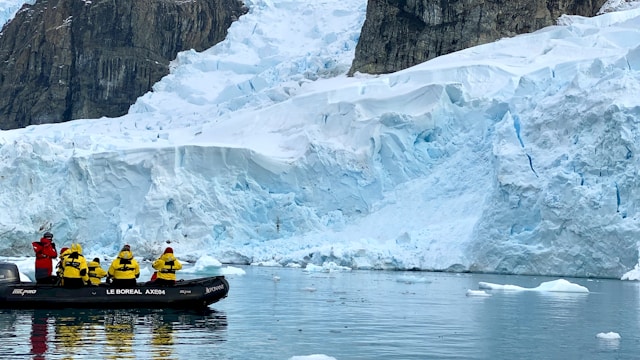
1. Muck Boot- Arctic Ice Tall
Click here for men’s | Click here for women’s
Muck boots are one of the most common rental boots you’ll find on expedition ships.
These Arctic wellies have extended rubber protection so they keep you dry in deeper waters.
The inner boot offers an 8 mm neoprene layer and is lined with fleece for optimal comfort and warmth.
The men’s boots are available in sizes 7-15 while the women’s are between 5-11.
💡 Pro Tip #2: Make sure to size up your boots 1-2 sizes so that you can wear thick wool socks comfortably on expeditions.
2. BOGS- Ultra High Tall Insulated
BOGS is the second most popular rental boot Antarctic cruises use for shore landings.
These ultra-high BOGS are comfort-rated for up to -40F and are available for sizes 5-16.
The brand also promotes these products as featuring “DuraFresh bio-technology,” effectively combating unpleasant odors.
3. Muck Boot- Arctic Ice Mid Height
Click here for men’s | Click here for women’s
While the taller, knee-high boots are recommended for landings as they are all via zodiacs and quite wet, there are instances where the shorter boots might be more feasible.
This might be the case for someone whose calves don’t fit comfortably in tall boots.
Given the circumstances, the mid-height Muck boots would be the perfect solution.
While some landings may be only in ankle-deep water, waterproof rain pants are worn over the boots to create a seal that keeps your legs dry, even in deeper waters.
This ensures optimal protection and comfort during your excursions.

Best Hiking Boots for Antarctica
If you’re visiting Antarctica not via boat, you’ll probably need a good pair of hiking boots.
This section is for people working at Antarctic research stations or staying at field camps.
It’s generally recommended that you get hiking boots that aren’t insulated, for a couple of reasons:
▶️ It’s usually too warm to wear these in the summer (especially McMurdo)
▶️ If you’re staying on the Ice for winter, you’ll end up wearing your gear-issued ECW boots instead when outside.
As I mentioned before, you’ll want to make sure you get a pair slightly larger than what you’d normally wear to accommodate thicker socks (Darn Tough and Smartwool are Ice favorites).
4. Columbia- Newton Ridge Plus
Click here for men’s | Click here for women’s
These are the hiking boots I’ve worn in both McMurdo and South Pole for over three years.
They’re great for every day walking around Mactown, hikes to Castle Rock, and even quick visits between buildings at Pole during the summer.
I love that they’re lightweight, which keeps the limited luggage weight down.
They’re a no-brainer for my McMurdo packing list.
5. Merrell- Moab 3 Mid
Click here for men’s: | Click here for women’s
Merrell hiking boots are a favorite among Ice vets.
The Merrell Moab 3 Mid hiking boots feature a breathable mesh, ensuring your feet stay dry and comfortable even during strenuous hikes.
Another great feature the boots offer is the Merrell Air Cushion in the heel, which provides excellent shock absorption and stability.
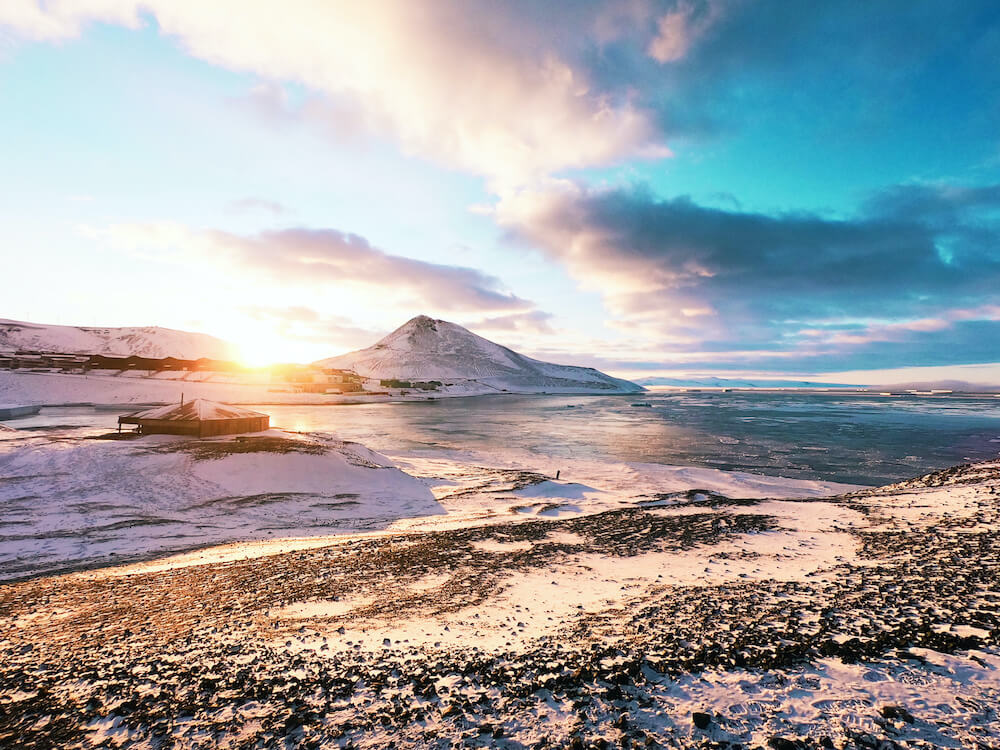
Best Mountaineering Boots for Antarctic Expeditions
This section covers boots needed for expedition tours:
6. Climb Antarctica- La Sportiva Baruntse
Plastic mountaineering boots are on ALE’s packing list for their “Climb Antarctica” expedition.
You’ll want plastic boots as you’ll encounter a variety of terrain at Heritage Ridge including rocks, ice, and snow.
A good set of foam liners is also important for keeping your feet warm.
The La Sportiva Baruntse is one of the top ones that they recommend as it provides great ankle support and a stiff sole.
7. Mt. Vinson or Mt. Sidley- La Sportiva Olympus Mons Cube
For Antarctic expeditions to Mount Vinson or Mount Sidley, you need the La Sportiva Olympus Mons Cube as temps can drop to as low as -40°F/-40°C.
These mountaineering boots are not only great for extreme cold weather, but also for high altitudes.
Due to the nature of this expedition, you’ll need to make sure your boots can fit two pairs of socks.
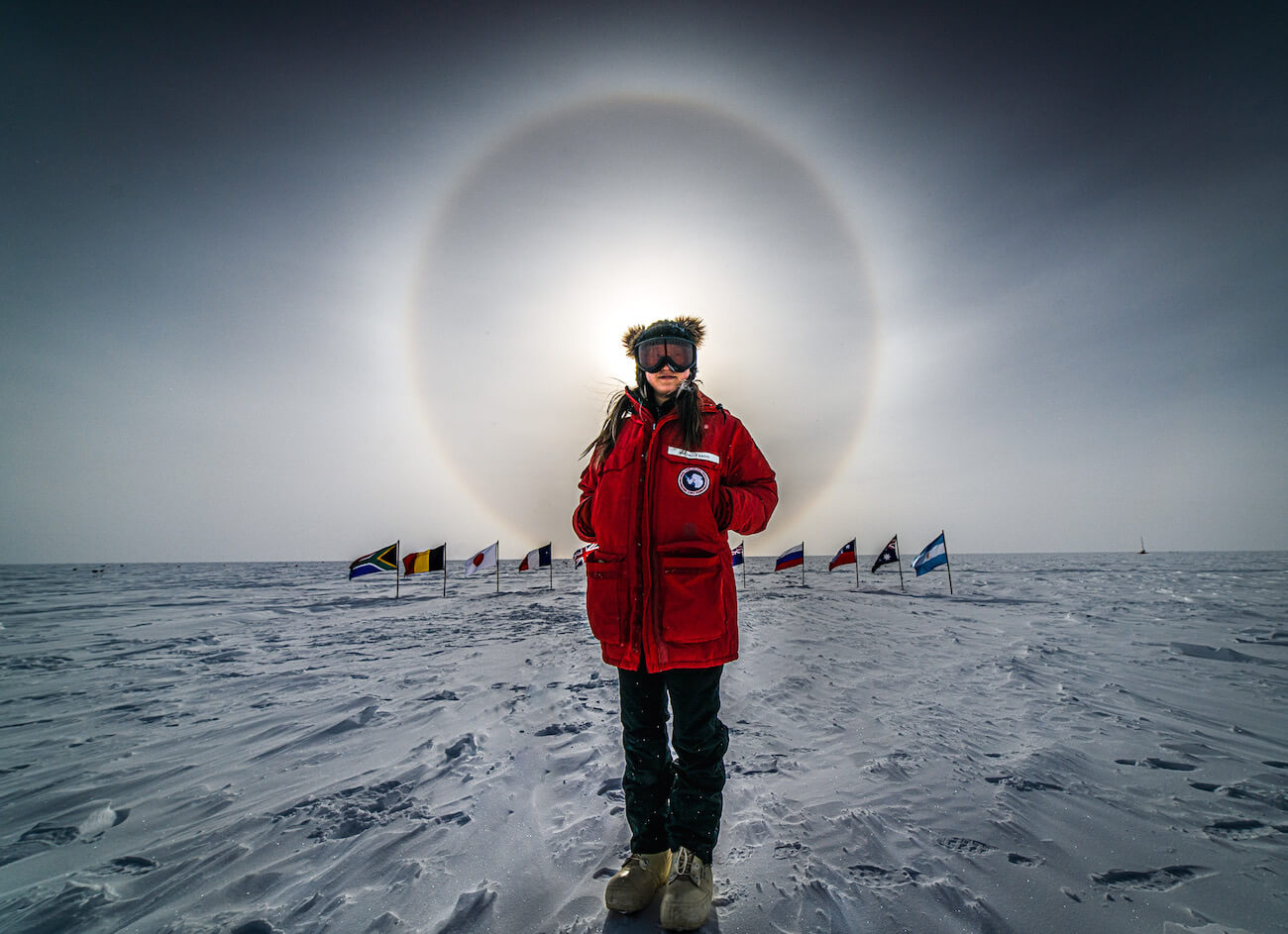
Best Boots for Working in Antarctica
The type of work boots you’ll need for the Ice depends on a few factors:
- Job (steward vs. electrician)
- Location (McMurdo vs. South Pole)
- Season (summer vs. winter)
Keep these in mind and I’ll do my best to explain as we go through the most popular boots people use for work.
Best Safety Toe Boots for Working in Antarctica
It’s generally recommended to avoid steel toed boots if you can because they can only be for indoor use.
If your job requires spending extended periods outside, you’ll come into contact with ice.
The steel toe, acting as a thermal conductor, can freeze your toes.
Instead, look for composite toe boots.
💡 Pro Tip #3: If your contract is with Amentum and your job requires safety shoes, you may be reimbursed for up to $200 every two years for your boots.
9. Timberland Boondock 8” Composite Toe
✅ 200 g insulation
✅ Good for McMurdo
200 g of insulation will suffice for McMurdo– not too hot during the summer but still keeps you warm in the winter.
My partner wore boots at this insulation level in McMurdo’s heated shop and said they were still comfortable to work in.
⚠️ Note: There are similar ones on Amazon but I couldn’t confirm the insulation rating; so if you look for this pair from Amazon make sure to check the details.

10. Carhartt Men’s Ruggedflex Safety Toe Work Boot
✅ 400 g insulation
✅ Good for McMurdo winter though some might find it too warm
If you run on the cold side, a work boot with 400 g of insulation might be a better fit for you.
This is probably too warm for McMurdo summers where the temperature can reach as high as 46°F (8°C).
However, it might work well for winters.
In the winter, McMurdo typically sees an average high of -1°F (-18°C) and low of -17°F (-27°C).
11. Timberland PRO Men’s 8″ Boondock Comp-Toe Waterproof Work Boot
✅ 1000 g insulation
✅ Good for South Pole
These are the boots that my partner wore throughout our summer and winter at the South Pole.
He was the shop foreman and was frequently outside for long periods of time working on the machines and vehicles.
Although heavy and a bit clumsy, he said these kept him warm even in the coldest winter temps.
For reference, the coldest it got at Pole our winter (2023) was around -106°F (-77°C) ambient.
These boots come with a range of impressive features, including an Anti-Fatigue Technology footbed for absorbing shocks and providing all-day comfort.
The moisture-wicking lining keeps your feet dry while the rubber toe protector offers an additional layer of safety.
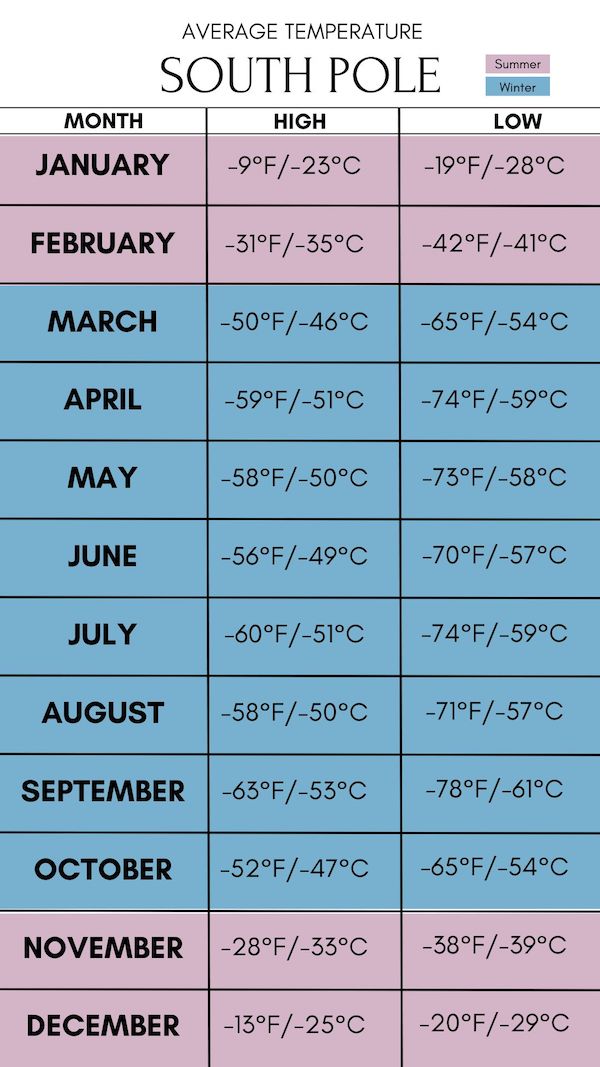
12. Carhartt Men’s 10″ Waterproof Insulated PAC Composite Toe Boot
✅ 1000 g insulation
✅ Good for South Pole
If you’re a die-hard Carhartt kind of person, these 1000 g composite toe boots will do the trick.
Even if you’re only spending the summer at the South Pole, the average temperature during this time is in the -20s°F, so you’ll still want plenty of insulation.
These boots come with a foam cushion insole and arch support to keep you comfortable while you’re on your feet.
There’s also extra protection around the toes and heels as well as ankle support for increased stability.
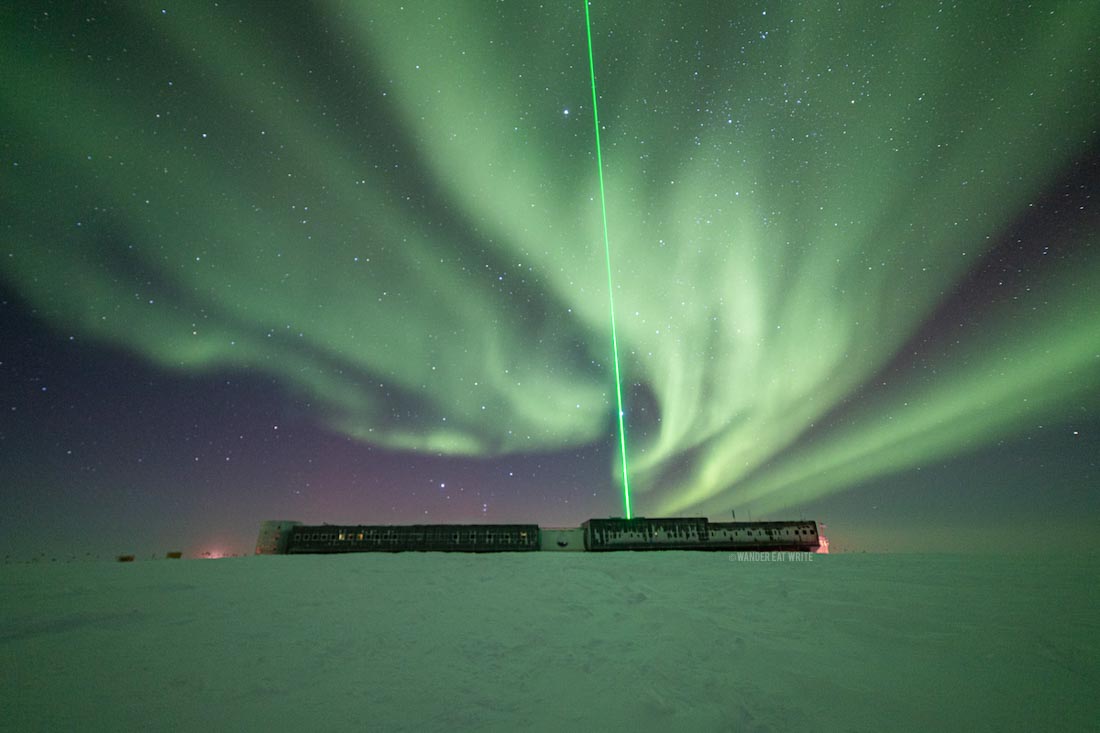
Best Non-Safety Insulated Boots for Working in Antarctica
If your job doesn’t require safety shoes but you’re still looking for a good, warm work boot, look into the Rocky Bear Claw:
13. ROCKY BearClaw GORE-TEX® Waterproof 200G Insulated Outdoor Boot
✅ 200 g insulation
✅ Good for McMurdo
This boot comes with 200 g insulation so it’s warm enough if you are outside often for work.
Crafted with premium full-grain leather and robust nylon, these Rocky Bear Claws feature breathable GORE-TEX to keep your feet dry.
They also have a cushioned footbed for additional comfort.
Best Work Boots for Stewards in Antarctica
This section applies specifically to kitchen stewards, although it can also go for other galley personnel as well as janos.
Remember, your shoes need to be black and closed-toe.
💡 Pro Tip #4: You’ll also want to make sure they’re at least water resistant if not waterproof as stewies are dealing with a lot of water on the feet while washing dishes and pots.
I made the mistake my first year as a stewie bringing sneakers with a mesh top as my work shoes and boy did I pay the price.
No one told me how much water would be dumped upon my feet, and so I had drenched socks everyday.
💡 Pro Tip #5: If you’re doing a full year on the ice– particularly at McMurdo– you may want to have a different set of shoes to wear between your dorm (if you’re not in Building 155) and work (155).
Having a backup pair of work shoes is also advisable as well since getting new shoes down if yours get destroyed will be next to impossible.
This is because the path becomes quite slippery as the temperature drops, effectively turning your non-slips into full on slips.
Also, the volcanic rock wears down the non-slip treads pretty quickly when you’re not skating around like a penguin, so keep that in mind.
Anyway, here are my top two recommendations for work shoes in the kitchen:
14. Dr. Martens 1460 Original
These have been my go-to for my last three seasons in the galley at both McMurdo and South Pole.
They keep water out, my feet stay dry, and are super comfortable to wear all day.
Bonus points for also being stylish enough to wear outside of work as well as off the Ice and even special occasions.
At Pole, these paired well with the dresses I wore for working our holiday meals as I needed non-slip shoes to run back and forth between the dining room and kitchen but still looked great with my outfit.
💡 Pro Tip #6: if you have small enough feet like me, the youth sizes are WAY cheaper, and also come with a side zip option!
15. Dr. Martens 2976 Chelsea
These are another great option I saw many chefs, cooks, and stewards wear.
Some prefer these as they’re not as tall, others like them because there are no laces.
They’re just as comfortable, fit the uniform standards, and also look good if you want to wear them outside of work.
💡 Pro Tip #7: This is the only time I wouldn’t recommend sizing up for boots.
You’ll be working in a heated building at a comfortable temperature, and at times sweltering.
Regular everyday socks will suffice, so order these work boots at your normal shoe size.

Best Extreme Cold Weather Boots
You may need to purchase these if you’re doing an expedition and rental isn’t an option.
Obviously, rent if you can.
I sometimes see questions from people going on cruises to Antarctica asking if they need these heavy duty boots, and the answer is no.
If you’re working at an Antarctic research station, you’ll be issued a set as part of your mandatory Extreme Cold Weather (ECW) gear so you don’t have to worry about purchasing your own.
But if you do need to purchase a pair or you’re just curious, here are the most popular extreme cold weather boots for Antarctica:
16. Baffin Apex
Baffins are the favorites when it comes to ECW boots.
This particular pair is rated for temps up to -148°F (-100°C), which makes it perfect for South Pole winters.
They offer eight layers of insulation and plenty of cushion and support.
While they do have a heft to them and are cumbersome to wear much like other boots made for the extreme cold, they definitely do their part in keeping you warm.
17. Bonus: Asics Arctic Tiger aka FDX Boots
While these are no longer available to purchase outside of resale stores like E-Bay, I couldn’t leave them off the list because these are my Antarctic ECW boot of choice.
And I guess this little bonus section here is my unsolicited love letter to the FDX boots that the United States Antarctic Program is unfortunately phasing out.
The boots come with a removable fleece bootie that I often wore as slippers indoors, and they kept my feet so warm despite the harsh winter temperatures at the South Pole.
Anytime I went outside for walks or to see the auroras in -100°F temps, these bad boys not only saved my toes from freezing, but also allowed me to stay out for longer.
Those who haven’t been to the South Pole during the winter may not understand, but when it’s a nice day (as in no wind that hurts your face as soon as you walk out) with clear skies– you don’t want to go inside until you absolutely have to.
The Southern Lights (not called Northern Lights in Antarctica) are just so special and unlike anything I’ve ever seen before.
They’re also something just under 2000 people in history have ever been able to see in their lifetime.
So when I could be out to enjoy them without literally freezing to death– I wanted to be out.
These FDX boots were just… *chef’s kiss*
FAQ: Best Boots for Antarctica
Here are some frequently asked questions about boots in Antarctica:
What boots do they use in Antarctica?
There are a variety of boots used in Antarctica for different purposes.
For cruises with shore landings, they are typically very wet so waterproof gum boots are used.
For expeditions, mountaineering boots are required.
For those working at Antarctic research stations, composite-toe safety boots and non-slip boots are commonly seen.
Everyone flying to Antarctica will also need a pair of extreme cold weather boots such as Baffins which are usually provided.
Will my cruise provide waterproof boots for landings?
Yes, your cruise will provide waterproof boots for shore landings.
Some offer them for free and others rent them.
While the cruise ships do their best to cover a range of sizes, there are instances where they may not have your specific boot size.
If you wear a size either on the smaller or larger end of the spectrum and have concerns, contact your cruise line for more information.
What shoes do you need for Antarctica cruises?
As not all Antarctic cruises are the same, you should double check your cruise’s suggested packing list.
Generally speaking, you’ll just need regular, everyday shoes that you’d wear at home for while you’re onboard.
You may also need a set of hiking boots depending on the excursions.
However, most– if not all– of the time you do landings you’ll be wearing the waterproof boots provided.
What shoes do I need for working indoors in Antarctica?
If your job in Antarctica is indoors, you can probably wear any type of sneaker or hiking boot that’s comfortable.
This is assuming it’s an administrative role or other job at a desk.
However, you should double check your job’s clothing requirements for your position.
Those working in the kitchen will definitely need non-slip, closed black shoes, ideally ones that are at least water resistant.

Final Thoughts: Antarctica Boots Review
Not all boots are equal when it comes to Antarctica.
The main thing to remember is what type of visitor you are as that will decide what type of boot you’ll need.
I know it’s hard to find information online about what boots are best suited for your trip, so I hope this was helpful!
If you’ve been to Antarctica and have any extra insight on this topic, feel free to contact me and let me know so I can make sure I’m giving out the most useful information I can.
